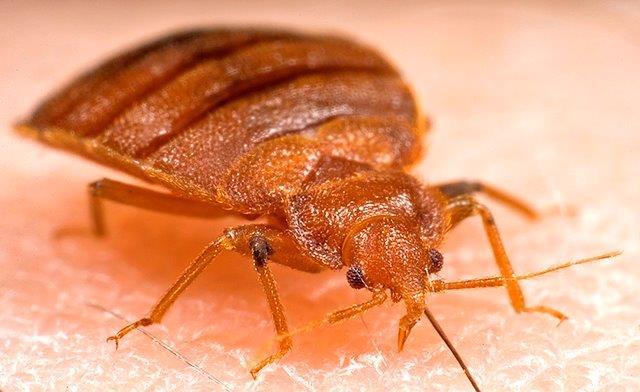EMBARGOED FOR RELEASE | September 09, 2013
How bedbugs shrug off pesticides and simple measures to deal with it
Note to journalists: Please report that this research was presented at a meeting of the American Chemical Society.
INDIANAPOLIS, Sept. 9, 2013 — The bedbug’s most closely guarded secrets — stashed away in protective armor that enables these blood-sucking little nasties to shrug off insecticides and thrive in homes and hotels — are on the agenda here today at a major scientific meeting.
In a talk at the 246th National Meeting & Exposition of the American Chemical Society (ACS), the world’s largest scientific society, scientists are describing identification of the genes responsibe for pesticide-resistance in bedbugs, and the implications for millions of people trying to cope with bedbug infestations that have been resurging for more than a decade.
The bedbug presentation is part of an international research award symposium at the ACS National Meeting, which includes 12 other research papers on topics ranging from pesticide resistance to monitoring chemicals in the environment to tick spit.
“Every living thing on Earth has a unique set of strategies to adapt to life-threatening situations in the environment,” said Fang Zhu, Ph.D., a leader of the research who spoke at the meeting. “The surprise discovery we never expected is that most of the genes responsible for pesticide resistance in the bedbug are active in its outer skin-like shell or cuticle. This is the unique adaption that has not been discovered in cockroaches, termites, ants or other insects.”
Zhu of Washington State University and colleagues, who are with the University of Kentucky, quickly realized that the location was the ideal spot for genes that mute the effects of pyrethroid insecticides — today’s mainstay home and garden pesticides. The bodies of bedbugs, she explained, are extremely flat before the creatures slurp up a meal of human blood. That profile adapts bedbugs for a life of hiding in the seams of mattresses, upholstered chairs, the lining of suitcases and other concealed locations. But it also creates a vulnerability to environmental toxins, giving bedbugs an unusually large surface area where pesticides can enter their bodies. The shell is tough — and accounts for the difficulty in squashing a bedbug. But research by Zhu’s team and others has established that it’s also a metabolic hot spot to protect against insecticides. Some genes in the cuticle, for instance, produce substances that tear apart the molecular backbone of insecticides, rendering them harmless. Other genes manufacture biological pumps that literally pump insecticides back out of the cuticle before they can enter the body.
Zhu’s team sifted through the bedbug’s genome — its complete set of genes — to identify the genes responsible for this pesticide resistance. They studied 21 populations of bedbugs from cities in Ohio and Kentucky (Cincinnati, Lexington and Louisville) that were plagued with bedbug infestations.
“We took advantage of cutting-edge next-generation genetic sequencing technology that’s now available. It enabled us to perform quickly an analysis that would have taken years in the 1990s — a genome-wide analysis of the insecticide-resistance related genes in bedbugs.”
They found 14 genes that in various combinations help bedbugs survive pesticide treatments with pyrethroid-type insecticides. Most were active in the bug’s cuticle, and block or slow an insecticide from reaching the nerve cells where it can kill. In addition to this first-line of defense, Zhu’s team discovered that bedbugs have developed a second layer of protection. In case insecticides slip past the armor, other genes kick in to prevent the toxins from attacking the nervous system.
Zhu said the findings suggest that development of new pesticides should focus on chemicals that shut down or mute genes in the cuticle that thwart today’s pesticides. New pesticides alone, however, will not be enough to cope with the bedbug resurgence. Zhu cited evidence that bedbugs in laboratory colonies exposed to lethal doses of pyrethroids begin to develop resistance within a few generations, which can be less than one year.
“It reminds us how quickly a new insecticide can become ineffective,” she said. “In the future, efficient bedbug management should not rely on any single insecticide. We need to combine as many chemical and non-chemical approaches as we have to get rid of the infestation.”
She cited, specifically, integrated pest management for bedbugs, approaches in which careful use of pesticides combines with other, common-sense measures. Those include removing bedroom clutter where bedbugs can hide, frequent vacuuming of dust and other debris, washing bed linens in hot water and heat-drying in a dryer, and sealing cracks and crevices to eliminate hiding places.
Zhu’s colleagues with the University of Kentucky include Subba R. Palli, Ph.D.; Kenneth F. Haynes, Ph.D.; Michael F. Potter, Ph.D.; Hemant Gujar; and Jennifer R. Gordon.
For more information on the bedbug problem: http://www.cdc.gov/nceh/ehs/publications/bed_bugs_cdc-epa_statement.htm.
To automatically receive news releases from the American Chemical Society, contact newsroom@acs.org.
# # #
The American Chemical Society is a nonprofit organization chartered by the U.S. Congress. With more than 163,000 members, ACS is the world's largest scientific society and a global leader in providing access to chemistry-related research through its multiple databases, peer-reviewed journals and scientific conferences. Its main offices are in Washington, D.C., and Columbus, Ohio.
Media Contact
During the national meeting, Sept. 6-11, the contacts can be reached at 317-262-5907.
Michael Bernstein
m_bernstein@acs.org
202-872-6042
Michael Woods
m_woods@acs.org
202-872-6293






